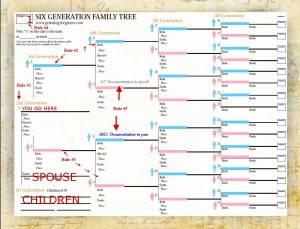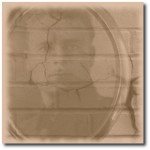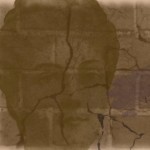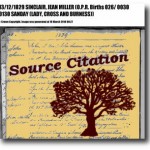Introduction to Genealogy
The Language of Genealogy: Understanding Old Documents
April 24, 2012 by ramona
Filed under Articles, Getting Started in Genealogy, Introduction to Genealogy, Latest News
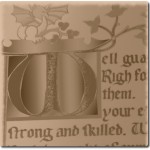 Today’s language is quite different from the daily language of our ancestors. Some words and their meanings have all but disappeared from the modern lexicon.
Today’s language is quite different from the daily language of our ancestors. Some words and their meanings have all but disappeared from the modern lexicon.
For the Genealogy Beginner this can make reading old documents confusing if not outright frustrating.
Archaic Genealogical References
Recently I was assisting a novice genealogist in transcribing a document from the 1600s that they had been working on for some time. A huge part of the problem they were facing stemmed from an unfamiliarity of the language of the times. To make it worse the unfamiliar words were written in an abbreviated form of the times.
Transcribing old documents can be difficult enough on its own. The addition of archaic words and abbreviations that have no meaning in modern language simply makes the process nearly impossible; especially while simultaneously struggling with a old script in an aged document.
In this case, the words that were causing the problem were “Umqhuille”, “Relict” and “Milner”. Umqhuille is a word meaning deceased and Relict means Widow.
Milner in this time was a merchant who dealt in small, fancy goods. While the modern meaning of the word has changed to mean a seller of hats, the etymology of the word derives from Milan, from where many of these goods were once imported.
From working out the words, we were able to:
- Asses that the ancestor in question was deceased at the time of a particular baptism
- Recognize that one person on the document –Relict – was his wife
- Understand what his profession was
From this information, we added an additional generation to the family tree as the Umqhulille and relict named were the grand parents of the individual being baptized. This transcription also helped track down both a Will and a Sassine, which led to a great deal more information on the family researched.
This purpose of this little story is to demonstrate the importance of becoming familiar with the language of our ancestors. It is more than likely that novice Family tree hunters will run across some common and not-so-common old words while digging for their roots. For this, A genealogical dictionary would be a very helpful tool to have on hand.
Join us on the Ask a Genealogist Forum for a list of links to some excellent resources for archaic words, old occupations, medical terms and more.
Genealogy Scams and Red Flags
April 22, 2012 by ramona
Filed under Articles, Getting Started in Genealogy, Introduction to Genealogy, Latest News
 With the growing popularity of genealogy and family history, it is easy to find hundreds of internet sites dedicated to the subject; from sites claiming to have huge databases to others that promise to contain information relevant and specific to your family tree, surname or coat of arms.
With the growing popularity of genealogy and family history, it is easy to find hundreds of internet sites dedicated to the subject; from sites claiming to have huge databases to others that promise to contain information relevant and specific to your family tree, surname or coat of arms.
Beginning Genealogists should be aware that not every genealogy site is as good as the claims they make.
Genealogy Scams
While a great deal of family tree sites are trustworthy, newcomers to genealogy can sometimes fall prey to less reputable sites that exist to take your money and offer you zero results or results you could have found for free. Additionally family tree research novices should beware of “genealogy sites” that exist for the sole intention of gathering your personal information for the purpose of email marketing or worse…identity theft.
Before you enter your details for any family tree site, research the site to see what they are claiming to offer.
A reputable genealogy site will:
- List exactly the information, records and databases you can access once you have signed up
- State the locations and periods for which records are available
- State the source of the records or information they hold
Top Three Genealogy Site Red Flags:
#1. A site that makes generalized claims such as “Largest Genealogy Database”, “Millions of Names Free”, “Your Family Story” or simpler claims to “marriage or birth records” without any detail provided…should be avoided.
#2. Your “Free Search” results are ambiguous. For example, a search return that says they have found X-number of results on the name you entered without details. A good test of this kind of result is to type in a nonsense name such as Harry I. Balls or Jemima Pancakes to see how many results you get.
#3. A site that only provides an online contact form and does not list contact information such as a telephone number or address is not a good bet. A site without customer service is an absolute no go.
Although there are no 100%, fail-safes as these sites tend to come and go rather quickly. Following the above mentioned simple precautions may help you spot Red flags and make adding those names to your family template a safe and enjoyable experience.
The Basics of Norwegian Genealogy
April 9, 2012 by ramona
Filed under Articles, Genealogy Searches by Place, Introduction to Genealogy, Latest News
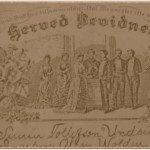 When tracing your Norwegian ancestors, you will learn that climbing your Norwegian Family Tree is a unique experience in genealogy research. From naming practices to language barriers and cultural differences, Norwegian genealogy is distinct in its resources and research techniques. In this article, Genealogy Beginner will pave your path with the basics of Norwegian genealogy research so you can start adding the names of your “Viking” forbearers to your family template.
When tracing your Norwegian ancestors, you will learn that climbing your Norwegian Family Tree is a unique experience in genealogy research. From naming practices to language barriers and cultural differences, Norwegian genealogy is distinct in its resources and research techniques. In this article, Genealogy Beginner will pave your path with the basics of Norwegian genealogy research so you can start adding the names of your “Viking” forbearers to your family template.
Ancestors From Norway: Getting Started
One of the first things you will need to understand about researching your ancestors from Norway is that the rules of following a single surname from generation to generation do not apply. Norwegian immigrants often took the name of the farm where they lived. This in itself can be a hint in your research. For example, in the case of two brothers, Johann Tollevson and Simon Tollevson who immigrated in the 1600’s one brother took the name Rugsveen and the other adopted the surname Undseth for the farms they were living on when they immigrated.
However once your research leaves the shores of North America your one name study ends. Prior to the 1900’s your Norwegian ancestors used a patronymic naming system where the child was given the first name of their father as a surname. In these cases, you will find, as in the case of the two brothers named above – Johann and Simon – that their fathers name was Tollev.
To get started digging for your Norwegian roots you will need your ancestors “Norwegian” name and date of birth along with the farm name where your ancestor lived. Although this may seem a little odd at first you will soon find that these peculiarities of Norwegian genealogy may be very helpful when searching out your ancestors from Norway.
Hints:
Norwegians were wonderful keepers of records and family bibles are very common
Norwegian dates are always written as…Day/Month/Year
Tools for Norwegian Genealogy
Once you have sorted out the names and dates of birth it is time to start gathering your research tools. Here is a short list to get you going.
– Family Tree Template
– Norwegian English Dictionary
– Word list for special terminology
Norway’s Genealogy Resources
Norway Church Registers
There are church registers for every parish in Norway with the oldest dating back to the mid 1600’s for some parishes. Records were recorded as both religious and and civil events for example a birth would be a civil event while a baptism is a religious event. Among the records of births, marriages and deaths you will often find entries of announcements made to the parish.
Norway Census
The earliest census in Norway took place in the 1600’s, these early census were called “Prestenes manntall” and recorded information for men, boys and sometimes widows. Sadly, Norway’s census records are incomplete and contain several errors, often with large parts of families missing. Beginning genealogists should know that Norwegian census is not considered a reliable source of information.
Bygdebok
Possibly the best resource for tracing your Norwegian ancestors is the Bydebok, a book of land records that contains a great deal of historic information. It often records a history of the families who owned the land… often into the 1300’s. Bygdebok are divided by communities listing the farms within one or two parishes and are a must have for anyone studying their Norwegian family history.
Other records available to genealogists are Probate, Mortgage and Tax Registers although like the census, the records are often incomplete.
The good news for anyone doing research on his or her ancestors from Norway is that there is a lot of information available on the internet. Join us on the Genealogy in General forum for a list of important links to get you started on your Norwegian genealogy.
Using DNA to Grow Your Family Tree: Guest Blog
April 5, 2012 by ramona
Filed under Articles, Getting Started in Genealogy, Introduction to Genealogy, Latest News
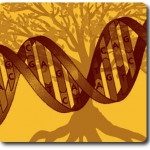 Genealogy Beginner Welcomes Guest Bloggers from the Sinclair DNA One name Study and the Salian DNA Project who have so wonderfully explained everything a genealogy beginner needs to know about how to use DNA testing to help with your genealogy research…and fill out your Family Tree Template!
Genealogy Beginner Welcomes Guest Bloggers from the Sinclair DNA One name Study and the Salian DNA Project who have so wonderfully explained everything a genealogy beginner needs to know about how to use DNA testing to help with your genealogy research…and fill out your Family Tree Template!
So what do you do when there are no more records to get you any further back in time on your family tree? Most of us get stuck at a brick wall which seems insurmountable and that’s where DNA comes in. By joining a DNA project and testing a male family member, you can compare that Y-DNA sample with others of the same surname.
Your Family Tree DNA: How It Works
Y-DNA is passed from father to son and contains a unique signature passed through the generations, which you share with the other project members. Another advantage is contact with others of the same surname to compare paper trails with and on top of that, you’ll find more relatives you didn’t have a clue existed, based all around the world.
In terms of cost, the least investment you can get away with is a 37 marker test and that would provide you with other matches of the same haplogroup as yourself. To be honest though, a 67 marker test though more costly, is far more revealing and those you matched at 37 markers will appear less closely related, whilst at 67 markers you can be fairly confident that those you match are descended from the same ancestor.
The closeness is measured in “genetic distance”; for example you could match exactly, or be one, two or more steps away in genetic distance from the other matches which will give a rough indication of how far back in time you relate to them.
DNA ONE-NAME STUDIES
There are plenty of one-name DNA studies on the internet but the majority of them use the www.FamilyTreeDNA.com laboratory for testing, mainly because they have the largest DNA database with 366,840 participants at the time of writing.
Some of these projects specialise in specific geographic areas and some in various ethnicities. For example, there are dedicated projects for those with Jewish, African or Native American ancestry as well as over 6,800 surname projects.
Not only can you compare your DNA with others of your own surname, you will be able to find matches across the whole of FamilyTreeDNA’s massive database as well which, strange as it may sound, can be extremely helpful in research terms.
Many adoptees have used DNA testing to find out who they really are by comparing their DNA results to the other surnames which show up in their matches, giving more clues to research their family history. You can join as many projects as you like or as many as are relevant to your family’s history and the other advantage of joining a project is a discounted price on the cost of your DNA test.
Just to be fair, there are other companies out there for example:
- Ancestry
- 23andme
- The Sorensen Molecular Genealogy Foundation
Who may be cheaper to test with than FamilyTreeDNA, but once those test results are in, there are considerably fewer other “testees” to compare your sample with and in the world of DNA testing for genealogical purposes, database size is everything!
DNA TESTS
Because DNA testing is still a relatively new science, using it to find relatives is the new frontier. Exciting developments are happening all the time and one of the latest such tools are “SNP’s” or “single-nucleotide polymorphisms”. These are small “mistakes” in the copying of DNA which occur just once and are then passed unchanged from generation to generation forever after.
Because they are much rarer, they are far more accurate in determining whether you relate closely to another potential match or not. The good news is that after the initial expense of a 37 or 67 marker test; testing individual “SNP’s” becomes more affordable when you want to take the plunge. That at least is a general outline of what happens.
Your Privacy
Privacy may be a worry for some, but your DNA sample is allotted a kit number and only that is shown on any project website along with the name of your earliest known ancestor and geographical location for him. (That is, provided you have signed a release form). If not, your DNA remains anonymous and no one will have access to it or your contact information. It’s your choice.
DNA is definitely a bit overwhelming at first; it’s true there is a lot to learn for the novice and it’s a constantly evolving science with new breakthroughs happening all the time, but that’s where your project leader should step in and explain what it means for you personally and for the project as a whole; advise whether it’s worth testing this or that.
DNA Communities
Most projects have forums on Yahoo and Google or even on Facebook which are very informative and specifically targeted to the project or projects you have joined. There is nothing to stop you joining as many projects and forums as may be relevant to your family history.
A word of caution though; no one has all the answers yet and you should not jump in expecting that your project leader will necessarily be an expert in the DNA field, although in general they have access to population geneticists or other DNA boffins who are more than willing to help answer queries.
DNA and Realistic Expectations
Mainly these projects are run by slightly more experienced enthusiasts with the same goals as yourself. Also, you may or may not find someone else with a paper trail you can connect to yours immediately, so don’t expect miracles.
It may even take years for the magic to happen where you find that elusive document which connects you on paper as well as with DNA. However, the DNA alone, matching others in your project means you are related to them at some point since the adoption of surnames began around the 12th or 13th century and you have a shared history and that’s a fairly exclusive club!

The Salian DNA Project: A New Direction in Genealogy
Genealogy + DNA + Archaeology = An Exciting New Direction for Family Tree Fanatics
Just to illustrate what DNA plus historical and archaeological research can achieve for genealogy:
Archaeology and Your Family Tree
Archaeology is playing an important part alongside the historical record and the Y-DNA. From the archaeological record in recent years, two ancient gravesites containing multiple burials:
- one dated to 670AD in Ergolding, Bavaria in southern Germany
- another dated to between 1000 and 700BC in Lichtenstein in central Germany
Thirteen of the skeletons excavated have been DNA tested and the results from four of them, (one at Lichtenstein and three at Ergolding), were found to have a distinctive marker, the S21 SNP.
The Ergolding results are the most interesting of the two, as there were high-value grave goods found alongside the skeletons, indicating that these burials were related to the Merovingian royal household, (according to the archaeologists, Dr Vanek et al), hence the connection with the Salian Franks; the ancestors of the Merovingian dynasty.
When Archaeology Meets DNA
The S21 SNP was discovered back in 2004 by Professor Ken Nordtvedt of Montana State University who announced that it represented those with Frisian ancestry; [Frisia was located in what is now the Netherlands, Germany and Denmark on the North Sea coast of Europe] and the date for this SNP was determined to be approximately 4,000 years ago. We now know from subsequent research that there are several clades [or branches] below S21, which are younger than that.
Several SNPs have been discovered over the past year, which have added to our knowledge and brought us further forward in time to about 1,900 years ago. There is a clade (or branch) of this S21 SNP which is Frisian/Anglo-Saxon in origin because that is where the highest concentration of matching samples in the local population are found today, however, S21 has other clades within it as well, which may represent a different branches, perhaps from associated tribes. The Salian Franks were settled in Toxandria, in close proximity to Frisia, just directly south of there, in fact and their homeland became part of what we today know of as The Netherlands and Belgium.
Our ancestors were far more mobile than we perhaps imagine and moving around within northern Europe 4,000 years ago, intermingling with other tribes in other nearby areas, but with no documentation that far back, we are struggling through the fog of distant time. In the years to come, that fog may be eradicated altogether.
The Genealogy Aspect
A large number of participants in the Salian DNA Project are named Sinclair with ancestral links to Caithness, Orkney and Shetland. Through the work of population geneticists such as Dr Jim Wilson at the University of Edinburgh, we know that our ancestors carrying the S21 SNP have left more evidence of their existence in eastern Scotland and eastern England. Indicating that our ancestors crossed the North Sea and invaded Britain at some point back in time and while through historical research we can document our common ancestor as Rollo, a Norwegian Viking, our family shows no sign of matching Norwegian DNA, so the old history books may well need to be rewritten.
Dr Wilson’s research in Orkney and Shetland has isolated those Sinclairs carrying the S21 SNP as being descendants of the Earldom Sinclair line. His extensive database shows the majority of Sinclairs in Orkney carry this SNP in their DNA and historically, there were no Sinclairs in the islands until shortly before Earl Henry Sinclair was installed as Earl in 1379. His family, based at Roslin, in Midlothian on the east coast of Scotland also fits with the evidence found of the S21 SNP in Scotland.
Salian DNA
The Salian DNA Project was designed to link all associated surnames, which have a common male ancestor and show the S21 SNP in their Y-DNA. A large proportion of them are Sinclairs, but anyone, as long as they have that all-important S21 SNP in their Y-DNA, can join, just make contact at: http://www.familytreedna.com/public/ulvungardynasty/default.aspx
Through the Salian DNA study, we are gradually narrowing down the geographical area of our origins and we have learnt a lot over the years. By sharing research as well as our DNA results it has also become gradually clear that many people who adopted the Sinclair surname back in the past, were not actually related to one another.
Surnames began to be adopted very slowly after the Norman Conquest of Britain in 1066 and another complication is the problem of “non-paternity events” or illegitimate male children given their mother’s surname, adoption, or alternatively born as the result of an affair and raised as a Sinclair or St Clair.
DNA has a way of winkling out those who adopted the name for whatever reason and drilling down to find the genuine descendants of a known ancestor with a documented history in the geographical areas where a family was known to have been in the more recent past.
It’s an absorbing and contagious hobby, so come and join us when you’ve taken that all important DNA test!
To learn more about this exciting study please join us on the Discovery Panel Forum for some fantastic links.
Fill out Your Family Template the Easy Way
March 29, 2012 by ramona
Filed under Articles, Getting Started in Genealogy, Introduction to Genealogy, Latest News
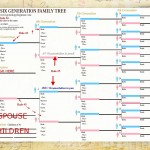 Have you ever felt confused about how to fill out a Family Tree Template?
Have you ever felt confused about how to fill out a Family Tree Template?
- Wondered what the numbers mean?
- Who you should include?
- Where to start?
Here are a few simple rules to follow that will have you filling out your Family Template in no time.
Family Template Rule #1 = YOU
Always start with yourself. Your name goes in the number one spot on the chart along with your vital statistics information such as when and where you were born. A space for the place and date of your marriage should be below that and if you look down many Family Tree Templates include an area to record the name of your spouse and children.
Family Template Rule #2 = MEN
Slightly indented and up from spot number one you should find the numbers two. This is where you will record your fathers name and information.
The rule if thumb:
- The males in your family will always have even numbers (2,4,6,8)
- The males in your family will always follow the upper track on a family template.
Family Template Rule #3 = WOMEN
Slightly indented and below number one you will find the number three spot
The Rule of thumb:
- The maternal lines of your family will always have odd numbers (3,5,7,9)
- The maternal lines of your family will always follow the bottom track on a Family Tree Template
Family Template Rule #4 = Generations
If you follow these rules through every generation, you will never be confused again. However, wait we are not quite finished yet. If you look on the upper left hand corner of your Family Template, you will notice a little box that says, “Chart#”. This area is needed for when you family tree goes beyond the number of generations on the chart.
Rule of Thumb:
- The template that includes you and your immediate family is always number one
- Number your Family Tree Templates consecutively to avoid confusion. For example if you were starting on a seventh generation, you would need to begin another Family Template and that template would be number two.
Note: Just below the “Chart #” box, there is a space that says “Note: “1” on this chart is the same as ____ on chart ____. This section is to help keep you organized when working with multiple Family Tree forms. For example if you were making a desendance report, this gives you a quick reference to where you can be found in the report.
Family Template Rule #5 = Documentation
All good genealogy research endeavors to document findings with copies or originals of birth, marriage and death records.
Rule of Thumb:
- Use a pencil to fill out the names for individuals for which you do not have documentation
- Use a pen to fill out the names for individuals for which you do have documentation
Family Template Rule #6 = Extended Family
Your Family Template is for your direct line of ancestry
Rule of Thumb:
- Uncles, aunts and cousins are not included on your Family Tree Template.
Here is a visual cue to help you get started (Click for a larger view)
Now that you are ready to begin filling in your family’s generations all you need is a Family Tree Template, just follow this link and download your FREE FAMILY TEMPLATE today.
Genealogy Brick Walls: Look In the Unlikely Places
March 18, 2012 by ramona
Filed under Articles, Genealogy Searches by Place, Introduction to Genealogy, Latest News
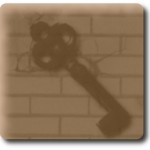 Hitting a brick wall in your family tree is an extremely frustrating experience for every family tree enthusiast from the novice to the advanced. Especially after, you have spent hours combing through all of the obvious records. When you have already checked the church records, civil records, obituaries, newspaper archives, immigration records and census…do not give up. Just realize that it is time to pull out your shovel and start digging deeper.
Hitting a brick wall in your family tree is an extremely frustrating experience for every family tree enthusiast from the novice to the advanced. Especially after, you have spent hours combing through all of the obvious records. When you have already checked the church records, civil records, obituaries, newspaper archives, immigration records and census…do not give up. Just realize that it is time to pull out your shovel and start digging deeper.
In short, after you have looked in all of the likely places the only places left to check are the unlikely ones.
Genealogy in the Unlikely Places
The unlikely places are usually the ones you ruled out your first time through. You may be very surprised at how much information you can find by looking in records that seemed irrelevant or illogical to your family tree research.
Finding Ancestors in Land Records
You have ruled this out because your ancestor did not own land, but did you know you could still find the record of a lease for a tenant farmer or rental agreement for your Great, Great Grandma’s city home.
Your Family Tree and Depositions
You have probably already checked the immigration records to see if your ancestors changed their name upon landing in the new country. However, did you know that many immigrants did not change their names until they were already naturalized citizens? If your ancestor decided to change their name after becoming a naturalized citizen, you would find this information in court records as depositions.
Name changes of this type often happened because immigrants felt a foreign name made their lives more difficult in their new home. If your ancestor has pulled a disappearing act, searching depositions for name changes would be a good place to start.
Historical Societies and Genealogy
Your local historical society (or the local historical society where your ancestor lived) may hold the clues you have been looking for. Historical societies are notorious for holding little known documents and unpublished works that are only listed within their collection.
One Family Tree Search is Never Enough
Newspaper archives may be something you have already checked. Nevertheless, you should try them again. Many genealogy beginners give up far too soon on this information source by stopping at a single search type. Any search of a newspaper archive should be undertaken with three search strategies.
- Search by Name
- Search by Date
- Search by Location
A newspaper can hold so much information in a single issue that not all names are indexed. That is why a three-tier search is necessary.
Although sometimes a brick wall in your genealogy research is due to records being lost in fires and wars, poor preservation and/or the records were simply not kept. The biggest problem with brick walls is that family enthusiasts either give up too soon or just don’t know where to look next. Should you have any questions or want a little extra help tackling your brick wall, please feel welcome to post your questions to the Ask a Genealogist forum. Genealogy Beginner looks forward to hearing from you.
Image Credit: Ramona Hartley
Genealogy Pitfalls: Genealogy Beginners Beware
March 9, 2012 by ramona
Filed under Articles, Getting Started in Genealogy, Introduction to Genealogy, Latest News
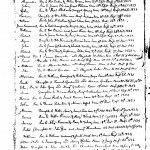 Recently while researching a family line, I discovered what I hoped might be a breakthrough on a frustrating brick wall. What I actually found was a good reason for beginning genealogists to use caution before including individuals in their family tree without first confirming the source. Truth to tell, this is a sad tale of how genealogy misinformation and mistakes are spread.
Recently while researching a family line, I discovered what I hoped might be a breakthrough on a frustrating brick wall. What I actually found was a good reason for beginning genealogists to use caution before including individuals in their family tree without first confirming the source. Truth to tell, this is a sad tale of how genealogy misinformation and mistakes are spread.
This story starts with a search for the parents of John McCallum b. about 1785.
I know that John was born on approximately this date from one source.
Monumental Inscriptions: Carnwath, County of Lanark for John McCallum
Death, noted: By Peter and J. McCallum to Fa. John 16/9/ 1839} 54; John McC. s. of Jas. 27/5/1865} 20; Janet Gibson w. of said John McC. 25/11/1876} 86; Said Jas McC. 27/6/1898} 81; Marion Law 9/4/1904} 83; their gdr nurse janet McC. 30/8/1902} 22.
I know the above named is my John McCallum from three separate sources:
1. From Statutrory Index 1916 – 1876 for the death of Janet McCallum:
Death November 25th, 1876
Fauldhouse, County of Linlithgow
At Rosebank, Fauldhouse, Parish of Whitburn
JANET MCCALLUM, 86, Widow of John McCallum, labourer
daughter of:-
F. Alexander Gibson………..deceased
M. Christine Gibson, m.s. Weir…deceased
Cause: Chronic Brights disease, 10 months
as cert. by John Crawford L.R.C.S.E.
Informant Isaac McCallum, Son, Present.
2. Statutory Index pre 1855 births 1824 & 1823 for the birth of William to John McCallum and Janet Gibson and consulted OPR 632/3 Carnwath, County of Lanark.
Birth: “William son to John McCallum and Janet Gibson born Oct. 4, Baptized 26th 1823.”
3. Statutory Index 1913-1916 for the death of William McCallum, In West Calder
Death: 1916, January 24th
West Calder, County of Midlothian
at 5 Davy street, Addiwell, West Calder
William McCallum, 92, Traffic Manager, Widower of Martha Walker.
Son of :-
F. John McCallum, Laborer…deceased
M. Janet McCallum, m.s. Gibson…deceased
Cause, Senile Decay, 1 month. As cert. by John Young, L.R.C.P.&S.E.
Informant James McCallum, Son.
Anatomy of an Ancestor Hunt
What I want to know is who Johns parents were, unfortunately Carnwath marriages are blank from 1735-1826. Additionally I have been unable to find a death record for John; two documents that could contain the information I need.
While searching for source documents or any clues as to the parentage of my John I ran across several family trees on the internet that named both my John, his wife and their children. A total of three family trees on Ancestry.com and one website, all naming John’s parents as John McCallum and Catherine Gray from Kilmicheal, Glassary, Argyll, Scotland
A Family Tree Cautionary Tale
Following this trail, I checked to see what sources they had cited…I found none listed. Still hopeful, I wrote to every lead and asked if they could help me locate the source they had used. Two Ancestry.com users answered that they had found the information from the other Ancestry.com tree and had not checked on the source. The other did not respond.
The website owner was lovely and sent me a copy of the birth registration from the OPR, here is a transcript.
09/01/1785 McCallum, John [OPR Births 511/000010 0061 Glassary]
“John McCallum Ashdaherlic & Catherine McCallum had a child named John”
Sadly, this is far from conclusive as there are eight other possible parents for my John McCallum b. 1785. (Note: this document does not give the mothers maiden name).
All couples listed below also had a son born 1785 named John McCallum.
- Donald Mccallum, Jean Graham ABERFOYLE,PERTH,SCOTLAND
- John Mccallum, Agnas Mcjock BUCHANAN, STIRLING, SCOTLAND
- Peter Mccallum, Janet Mclaren KENMORE,PERTH,SCOTLAND
- James Mccallum, Mary Forsyth BARONY,LANARK,SCOTLAND
- John Mccallum, Christian Jackson GLASGOW,LANARK,SCOTLAND
- Daniel Mcallum, Ann Mcallum STIRLING, STIRLING, SCOTLAND
- Hugh Mcallum, Katharine Mcfarlane BONHILL,DUNBARTON,SCOTLAND
- Daniel Mcallum, Ann Mcallum STIRLING, STIRLING, SCOTLAND
The Moral of the Story
As you can see from this story, it is very important to find documented sources before including someone in your family tree and publishing the information. It is just as important to remember that genealogy research sites are tools. Ancestry.com states “don’t take un-sourced documents at face value”. Finding your ancestor listed on someone else’s tree is not proof. Without a documentable source or two to back up your research you are simply guessing.
To learn more about avoiding pitfalls, citing sources and the standards of good genealogical research check out, Lesson 1: Beginning Genealogy – The Big Five.
Image Credit: Ramona Hartley
Genealogy Brick Walls: The Problem of Names
March 8, 2012 by ramona
Filed under Articles, Genealogy and Surnames, Introduction to Genealogy, Latest News
Nothing can stop your family tree research in its tracks like not being able to find your ancestors records. Usually, this boils down to the big four problems of names.
- Common names give too many options
- Spelling variations lead to confusion
- Misspellings can frustrate your efforts
- Indexing errors…are a fact of genealogy research
Brick Wall Problems with Common Names
The issue with common names is that they offer too many possibilities. If your ancestor is Joe Smith or Ole Olson your main question is going to be which one is mine? For example, a quick search for Ole Oleson, born 1830 in Rendalen, Norway, returns 632 records. You are going to need to employ some hard-core search strategies to find your Ole Oleson.
Brick Wall Problems with Spelling Variations and Spelling Mistakes
At the time of the early census there was no standardization for the spelling of names, consequently names were often spelled phonetically. Add to this the fact that not everyone had access to education (your ancestor may not have been able to spell or write their name) and it is not hard to imagine why we come up with so many variations on a single surname.
Another common problem of the time was simple human error. Spelling mistakes occurred frequently and for the same reasons as stated above. Additionally, immigrant ancestors may not have had a strong enough grasp of English to catch errors or perhaps the census taker had a difficult time understanding them.
On the other hand, they may have altered their name to a more anglicized version or changed it altogether.
Brick Wall Problems with Indexing Errors
Thank goodness for the volunteers who spend hours transcribing documents, these wonderful people are the ones responsible for making records readily available to family tree enthusiasts. I would never fault them for their efforts. If you have ever spent time as a volunteer indexer you would agree, old writing is sometimes so faded or illegible that mistakes are unavoidable.
In spite of the problem of names, brick walls can be annihilated. Here are a few approaches you can use to overcome them.
Brick Wall Genealogy General Rules of Thumb:
- Use Wild Card and Boolean searches
- Make a list of all possible spellings of your ancestor’s surname
- Find an ancestor with an uncommon first name and search with that to find your family
- Combine your search to include a spouse’s name
Common names, surname variants, misspellings and indexing errors while problematic are not insurmountable. Using some of the above brick wall tips combined with a sound research strategy read (Brick Wall Breakthroughs for Genealogy Beginners) will give you the tools to break down your brick wall and move forward with your research. Join us in the forum Ask a Genealogist where you will find four key strategies to solving your brick wall problem with names.
Image Credit: Ramona Hartley
Brick Wall Breakthroughs for Genealogy Beginners
March 4, 2012 by ramona
Filed under Articles, Genealogy Reports and Charts, Introduction to Genealogy, Latest News, Lesson 3 Articles
Brick wall busting is all about problem solving and detective work. However before you can begin to break down your brick wall you need to define exactly what the problem is.
The top four most common causes of brick walls:
Your brick wall may even stem from a combination of the above and that can feel like an overwhelming challenge to the genealogy beginner. What you need are the tools and strategies to keep you from being overwhelmed and that is the first step towards solving your brick wall problem.
Developing Your Brick Wall Search Strategy
A good search strategy for brick walls comes down to initiating three core actions:
Review Genealogy Your Data
Even if you have looked over your data a hundred times…do it again. The reason for implementing this strategy is to find the holes or weak points in your brick wall. For example, large time gaps between children are a big red flag; they indicate an area you need to look into more intensely. Locating the areas where you have gaps in your information will give you leads.
Chart Your Genealogy Research
After you have reviewed your information, chart it. Charting your research will give you an overview that can help you analyze information and spot gaps. A records checklist is one of the best charting strategies, although there are several you can work from to help achieve your goals.
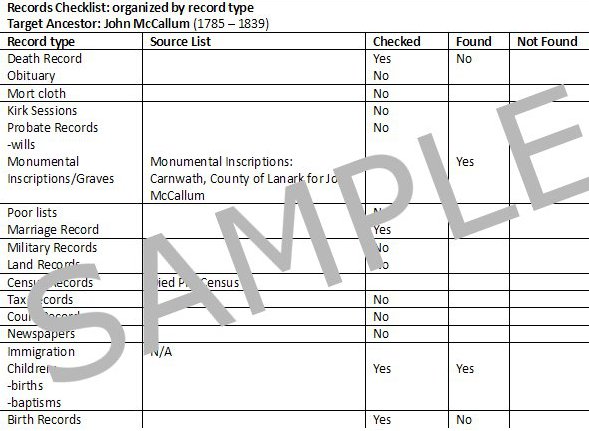
Map Your Locations
In addition to charting your research, another helpful search strategy is mapping. You may find that mapping your family tree will help you understand a little more about your ancestor’s lives as well as assist you in breaking down a brick wall.
Old Maps and Genealogy
Locating and using old maps can be a valuable resource for making a brick wall breakthrough.
- Understanding where county boundaries existed
- Noting border changes
- Discovering old place names that no longer exist
- Understanding the topography (through this you may learn how your ancestors traveled).
All of these things will point you in new directions and help you to discover record sources you may not otherwise consider. Additionally, knowing the lay of the land back then can lead you to the governing body that holds the records today.
Plotting Your Genealogy Research Map
Knowing your ancestors residences, where their children were born, where their spouse was born and where their relatives lived can help fill in gaps. The best way to develop a strong concept of this is to plot a map listing all of these locations.
Lanarkshire Map 1796
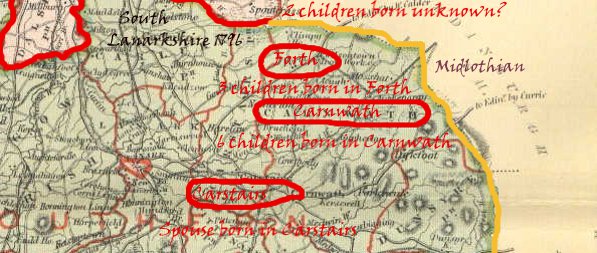
When you have finished plotting your historic map, plot a modern one, and then compare them for missing parishes or towns as well as county border changes.
Modern Lanarkshire Map
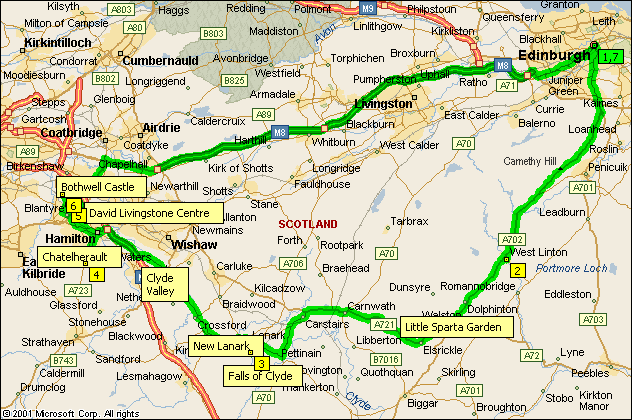
Once you have all of your information charted and mapped out, you will be prepared to make a full and comprehensive search that should help you break your brick wall.
Charting and mapping are only a few of the strategies you can use to help solve your brick wall problems. Genealogy Beginner will be bringing you more invaluable brick wall strategies very soon. For now, join us in the Ask a Genealogist forum and find more tips on charting your research.
Image Credit: Ramona Hartley
How to Cite Family Tree Information Sources
March 2, 2012 by ramona
Filed under Articles, Genealogy Standards & Guidelines, Introduction to Genealogy, Latest News, Lesson 1 Articles
As a family tree enthusiast, you are probably aware that your genealogical information comes from multiple places such as government agencies, Old Parish Records, monumental inscriptions, online genealogy sites, books and newspapers. No matter where you found the information about your ancestors it is simply good practice to cite your sources. The basics of citing a source are simple.
Citing a Genealogy Source Consists of Naming:
- Who created the source (publisher, historical society, government agency)
- What the source was titled (John O’ Groat’s Journal)
- When the information was created (copyright or year of publication)
- Where the information was created (State, County, and/or name of publisher)
- How you found it (name of repository or archive)
- Why it is a good source (primary, secondary or tertiary source)
Citing sources is particularly important if you plan to publish your family tree to the internet and it helps all of us involved in family tree research to sort out the reliable information from assumptions and guesswork.
Citing Sources for the Genealogy Beginner Citing sources can also be time consuming and confusing if you are not familiar with how to cite properly a source of genealogical information. For starters, here are some general helps and guidelines to citing a source.
Genealogy Citation Guidelines:
- <angle brackets> are for internet addresses <https://www.genealogybeginner.com/>
- [brackets] are for descriptive information
- Information about publishers should be in
- (parentheses)
Always cite exactly what you have found along with where you found it If you have doubts either leave it out or note is as a supposition.
For example in the case of a Monumental Inscription:
PETER SINCLAIR, CATHERINE CALDER Erected By Peter Sinclair In Memory Of His Wife Catherine Calder Who Died At Greentoft, 21st March 1905, Aged 72 Years. Also Peter Sinclair, Born At Cleat, Sanday, 12th June 1830, Died At Greentoft, Eday, 3rd January 1917
Citation:
Orkney Family History Society , “Orkney Graveyard Search for: Sinclair in Eday & Pharay, Old Kirkyard, St Marys, Eday Orkney” (Orkney Family History Society ) [Ray Millar ] <http://www.orkneyfhs.co.uk/mis/minscriptions.php?opt=gyard&gref=151&surname=Sinclair> Report date: 04/03/12
note: Eday, Orkney, Scotland: Eday Old Kirkyard, Orkney, Scotland Plot: 329
It also helps to become familiar with the abbreviations used in citing your family tree information sources along with the standard formats used. Standard
Abbreviations for Genealogical Citations

Standard Format for Online Genealogical Citations
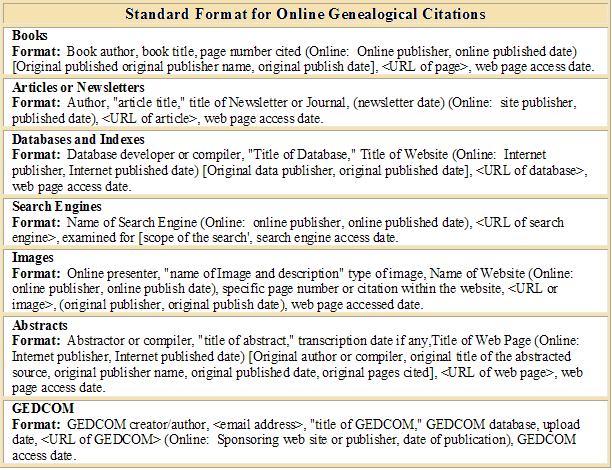
Citing your sources will give you the confidence to publish your family tree knowing that all of your hard work is beyond reproach. You can learn more about the importance of citing your family tree research and genealogy best practices in Genealogy Beginner’s Lesson 1: The Big Five Genealogy standards and guidelines: what you need to know first
Image Credit: Ramona Hartley

